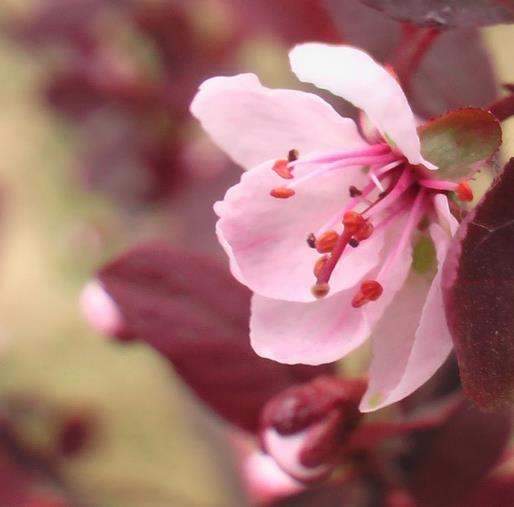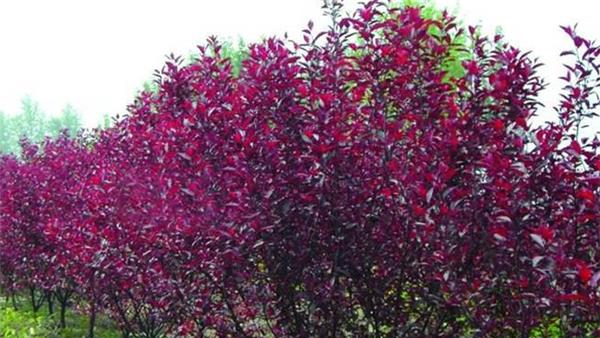Introduction and Culture skills of Dwarf Sakura the Red Sea World in the Green Field
Dwarf cherry is a kind of ornamental flower, which is beautiful in shape and sparse in branches and leaves, giving people a feeling of sparse flowers and leaves. It is a favorite of flower lovers. Let's take a look at it now.

First, the introduction of dwarf Sakura
Dwarf cherry is a deciduous shrub or small tree. The plant height is 1.8 m to 2.5 m, the crown width is 1.5 m to 2.8 m, the branches are purple-brown when young, and the old branches have lenticels. Dwarf cherry has good ornamental effect, fast growth, simple reproduction, resistance to pruning, strong adaptability and many advantages. Dwarf cherry generally use grafting and cutting propagation, grafting rootstocks generally use mountain apricot, mountain peach, apricot rootstock is the best. The ability of sprouting and tillering is strong, so it is easy to cultivate into balls or hedges in garden cultivation, form multi-branches by picking hearts many times, cut off miscellaneous branches before winter, and make heavy truncation of overgrown branches, which is ornamental with cultivation. Dwarf cherry hybrids include leaf plum and dwarf cherry. Dwarf cherry has a habit of enjoying an environment with plenty of sunshine and good ventilation. The soil is required to be fertile, loose, well drained and rich in organic matter. Cold-resistant, drought-resistant, avoid waterlogging. Dwarf cherry has strong adaptability, loose soil requirements, and grows well on well-drained, fertile sandy loam and light clay. There are few diseases and insect pests, extremely resistant to pruning, the semi-overcast condition can still remain purplish red, the root system is particularly developed, the absorption capacity is strong, and the requirements for water and fertilizer are not strict, which lies in the normal growth of drought, barren and gangue soil.

Second, the reproduction mode of dwarf cherry
Sowing, cutting and striping propagation are usually carried out in spring and summer.
1. Selection of cuttings
In the middle and last ten days of March, 1-2-year-old robust branches with a diameter of 0.5-0.8 cm were selected and stored in a sand pit. One layer of sand and one layer of cuttings, and seal the mouth of the kiln, in case the temperature is too high, bud germination or air loss, affecting the quality of cuttings.
two。 The time of insertion
It is best to be in the first and middle of May, when the temperature has rebounded, the temperature in the cold shed can reach 25 ℃, the ground temperature can reach 18 ℃ at night, and 20 ℃ in the daytime, which is beneficial to the rooting of cuttings.

3. The method of inserting must first make a good slotting machine.
Dig a bunker with a width of 1 meter, a length of 2 meters and a depth of about 25 meters in the cold shed (the length and width can be determined according to the size of the cold bed and the convenience of operation). After sieving, rinse and disinfect the sand, place it in the bunker, spread it evenly and compact it. The thickness is about 20 meters.
Then take out the cuttings refrigerated in the bunker and intercept 2 cm at each end. The cuttings are cut off from the base of the branches, and the cuttings are about 15 meters long. It is best to use a horseshoe-shaped oblique incision at the base to expand the contact area between the cuttings and the soil as far as possible, which is conducive to the absorption of water and oxygen and improve the survival rate. Put the intercepted cuttings base into a 10-fold mixture of 10% B-indoleacetic acid and B-indolebutyric acid, dip them in for 12 seconds and then dry them out for insertion (which can also be treated with rooting agents).
Insert the treated cuttings directly into the sand bed with a depth of 4-6 cm, which should not be too shallow, otherwise it will affect the rooting of the cuttings. There are 2 to 3 strong buds at the upper end, with a distance of not less than 5 meters. After insertion, pour thoroughly with warm water of 35 ℃ and shade.

4. Plug-in management
Shading must be done after insertion, so that you can see the light but not the sun, and the illuminance should be about 30%. The shed should be heated and moisturized, and the plastic arch shed should be added unconditionally. The temperature is best controlled between 20 and 28 ℃, and the humidity is about 80%. If the temperature is too high, ventilation or watering should be taken to reduce the temperature in the shed. When the humidity is too high, it should be ventilated and dampened. When the soil temperature is 3-5 ℃ higher than the air temperature, it is very beneficial to rooting. Warm water of 35 ℃ is often used to increase the soil temperature and irrigate once every morning and evening. In order to prevent the matrix and cuttings from producing mold, it is necessary to spray antibacterial drugs regularly, such as carbendazim, topiramate and so on. At 4-5 weeks after insertion, the root nodules were basically formed. At this time, the temperature has risen, and there is little rain and drought, the ventilation time should be prolonged, and the watering times should be increased to control the temperature and humidity. After 2-3 weeks, the root system is basically formed, and the young root can grow to 1-3 square meter, and then transplanted into the basin. It is best to transplant to a simple thin-walled soft plastic basin, where the soil should be compacted so that the soil in the basin can become a lump when planting. Shading, watering, placed under the shade shed, can be planted after 1 week.
Dwarf cherry generally uses grafting and cuttings to propagate, and grafting rootstocks generally use mountain apricot. Mountain peach, apricot rootstock is the best. Cutting grafting is used in spring and autumn, and bud grafting is used in summer and autumn. The rooting rate of oyster is 85%, and the survival rate is 80%. Purple leaf dwarf cherry has the general biological characteristics of Rosaceae and has strong sprouting ability, so it is very easy to cultivate into balls or hedges in garden cultivation, form multi-branches by picking hearts many times, cut off miscellaneous branches before winter, and re-cut the overgrown branches. Potted flowers after shedding change pots, cut short flower branches, leaving only the base 2-3 buds, you can use truncated branch modeling, the trunk, the main branches in time to climb, more sunshine. In late June, potted plants should control water and fertilizer, pay attention to modeling and promote branch enrichment. In fact, as long as the time is after the fallen leaves to before sprouting, the key is the temperature.
The above is the relevant knowledge of Dwarf Sakura. I hope I can help you.
Multiple branches are formed by picking the heart many times, and the miscellaneous branches are cut off before winter, and the overgrown branches are re-cut. Potted flowers after shedding change pots, cut short flower branches, leaving only the base 2-3 buds, you can use truncated branch modeling, the trunk, the main branches in time to climb, more sunshine. In late June, potted plants should control water and fertilizer, pay attention to modeling and promote branch enrichment. In fact, as long as the time is after the fallen leaves to before sprouting, the key is the temperature.
The above is the relevant knowledge of Dwarf Sakura. I hope I can help you.
Related
- Wuhan Hospital Iron Tree Blooming Result Was Instantly Frightened by the Gardener Master
- Which variety of camellia is the most fragrant and best? Which one do you like best?
- What is the small blue coat, the breeding methods and matters needing attention of the succulent plant
- Dormancy time and maintenance management of succulent plants during dormancy
- Minas succulent how to raise, Minas succulent plant pictures
- What are the varieties of winter succulent plants
- How to raise succulent plants in twelve rolls? let's take a look at some experience of breeding twelve rolls.
- Attention should be paid to water control for succulent plants during dormant period (winter and summer)
- Watering experience of twelve rolls of succulent plants
- Techniques for fertilizing succulent plants. An article will let you know how to fertilize succulent plants.



